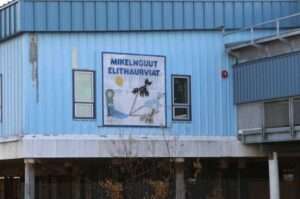
Yugtun is the most widely spoken native language in Alaska and the second largest in the United States, after Navajo. Bethel is the hub for Yugtun speakers, and the language is finally getting a curriculum and test that captures its core.
This February, the Lower Kuskokwim School District (LKSD) rolled out an innovative Yugtun language test for kindergarten through sixth-grade students in the district. They’re also piloting a new test for seventh- through 12th-graders.
“It’s hard to get really excited about a test,” said Christina Robbins, the director of elementary education for the district. “This test is really different for me.”
That’s because Yup’ik Elders, parents, teachers, retired teachers, and community members transformed the test. It measures things like speaking, reading, and writing, but also non-verbal skills and the Yup’ik worldview.
“Unlike, perhaps, what things have happened in the past, we’re not looking for students to check their culture at the door,” said Robbins.
This district covers a region with more Indigenous language speakers than any other part of the state. And in the majority of schools in the district, the kids are learning both Yugtun and English.
Around 2010, the district began to pilot a comprehensive Yup’ik immersion curriculum that not only teaches the language, but brings Yup’ik values and stories into the classroom. Robbins pulled out two textbooks to show me. One of them had a picture of a woman and child crossing the street on a crosswalk. The caption says, “I look both ways before I go.”
“There are not streetlights in village communities,” explained Robbins. “And in Bethel, there’s only the one that I have a picture of and it doesn’t ever turn green.”
So, Robbins asked, what are they actually trying to teach?
“Is this how a crosswalk works or is this about rules? And this is actually a unit about rules. So our picture for that same page, when we localize it, says rules also keep us safe. ‘I listen to an Elder. I stay away from dangerous spots. I respect others’ property.’”
This new test is designed to see if their localized curriculum works. How the kids perform will shape how they change the curriculum in the future.
“We also recognize that in defining what it means to be proficient in the Yugtun language, we’re going to have gaps in our curriculum,” Robbins said. “There isn’t a chapter in our language arts books that talks about nonverbal communication. It doesn’t come up in science or in social studies.”
Yet, for Yup’ik people, it’s obvious that the raise of the eyebrows means yes, and a head bob after a compliment on your earrings is a subtle brag. There are arm signals to alert others about danger, or a walrus, or a sinkhole. And it’s important to include all these things to help younger generations learn the Yup’ik way of life.
“For instance, in English we have, we have pronouns: this, that, and those,” explained Walkie Charles, who grew up speaking Yugtun at home. “In Yupik we have 30 of these pronouns. And these are more specific because of location, how I see my world: this; that; those; over there; those across there; those underneath; those up there; those that I can’t see upstairs; those that I cannot see that are down below; maybe in- or upriver; downriver. And so the way that I see my world has a language by which I’m able to use my pronouns.”
Charles teaches at the University of Alaska Fairbanks. He also runs the Alaska Native Language Center. He says that what LKSD is doing is significant. Bethel has become a model of how Yugtun and other Native languages should be taught.
“They don’t learn about things like skyscrapers, or escalators, or elevators,” Charles said.
Charles said that the district’s new direction speaks to the heart of language. They’re not just translating English, it’s drawing out the Yup’ik way of thinking. When Charles teaches Yugtun at the university, he finds that the younger generation often have not had much exposure to Native languages.
“I begin the semester by saying, ‘Welcome, welcome to Yugtun one-on-one.’” said Charles. “An emotionally charged language. Meaning, as we learn our heart language there’s going to be opportunities or times of which we’ll feel elated, humbled, and excited. Shame, remorse, guilt, and at the end too, you know, this feeling of finally gaining access to that language that wants to come out from the soul.”
Charles said that he sees his students have epiphany moments when the language and culture click and they understand something they couldn’t see in English.
“They go, ‘Ah, now, I now know why.’ Or ‘wow, I didn’t know that. So that’s why my grandmother would, holy.’ And then there’ll be, yes, there’s tears. It’s like, wow. Now I know,” Charles said.
The new tests are being administered until the end of March. After that, there may be some new curriculum on the way too.
Sunni Bean is a reporter and radio lover. Her favorite part of the job is sitting down and having a good conversation. She’s originally from Virginia, earned degrees in sociology and international relations at the University of Toronto, and learned Spanish working at a botanical garden in Bogota. Last year, she graduated from the Columbia Graduate School of Journalism.
Sunni Bean is a reporter and radio lover. Her favorite part of the job is sitting down and having a good conversation. She’s originally from Virginia, earned degrees in sociology and international relations at the University of Toronto, and learned Spanish working at a botanical garden in Bogota. Last year, she graduated from the Columbia Graduate School of Journalism.
